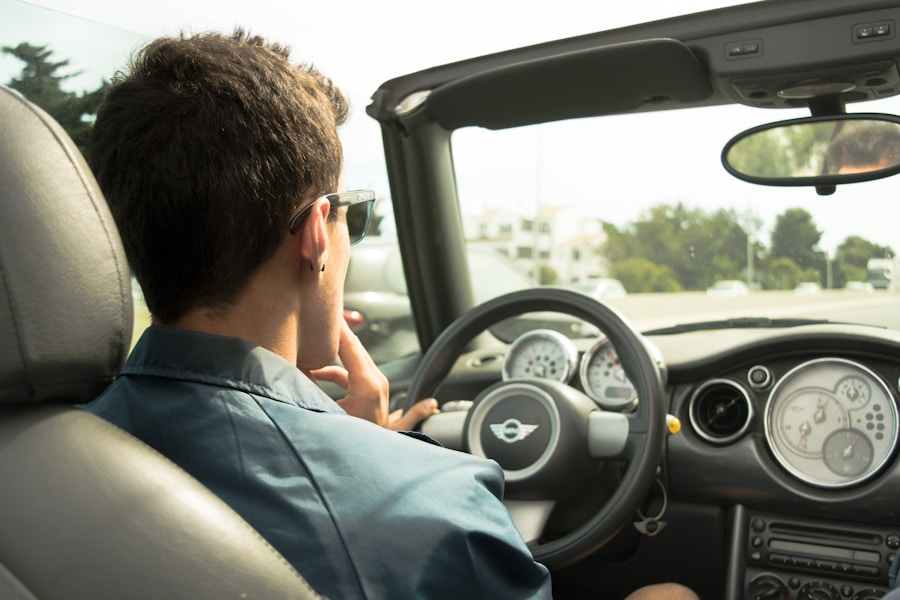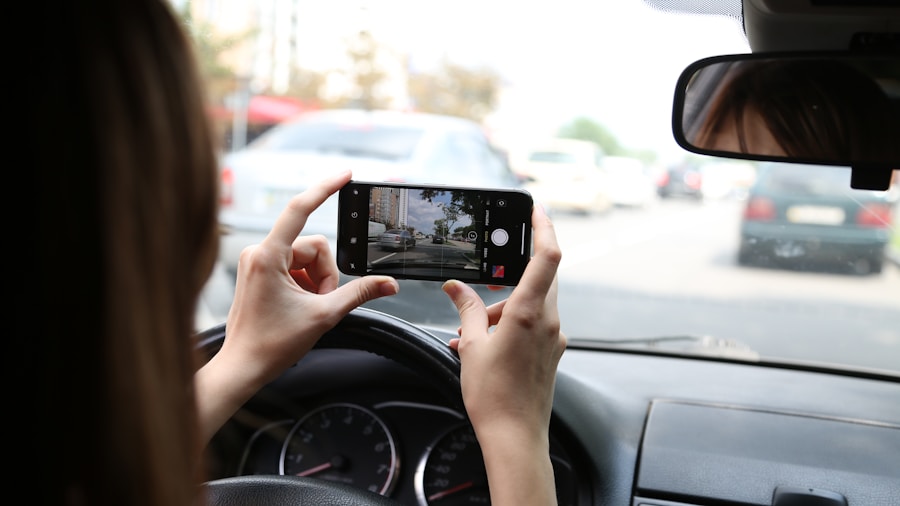Distracted driving has emerged as a significant public safety concern in recent years, capturing the attention of lawmakers, safety advocates, and the general public alike. Defined as any activity that diverts attention from driving, distracted driving encompasses a wide range of behaviors, from texting and talking on the phone to eating, adjusting the radio, or even engaging in conversations with passengers. The ubiquity of smartphones and other digital devices has exacerbated this issue, leading to an alarming increase in accidents and fatalities on the road.
According to the National Highway Traffic Safety Administration (NHTSA), in 2020 alone, 3,142 people lost their lives in crashes involving distracted drivers, highlighting the urgent need for awareness and action. The rise of distracted driving is not merely a consequence of technological advancement; it reflects broader societal changes in how individuals interact with their environments. As people become increasingly reliant on their devices for communication and entertainment, the temptation to engage with these technologies while driving grows stronger.
This phenomenon raises critical questions about personal responsibility, societal norms, and the effectiveness of existing regulations. Understanding the multifaceted nature of distracted driving is essential for developing effective strategies to mitigate its impact on road safety.
Key Takeaways
- Distracted driving is a dangerous behavior that involves any activity that diverts attention from driving, including texting, talking on the phone, eating, or using navigation systems.
- Distracted driving can lead to increased insurance rates due to the higher risk of accidents and claims associated with this behavior.
- Safety implications of distracted driving include an increased risk of accidents, injuries, and fatalities on the road.
- Types of distracted driving include visual (taking eyes off the road), manual (taking hands off the wheel), and cognitive (taking mind off driving) distractions.
- Technology plays a dual role in distracted driving, as it can both contribute to distractions (e.g. texting while driving) and also offer solutions to combat distracted driving (e.g. hands-free calling and voice-activated controls).
Distracted Driving and Insurance Rates
The relationship between distracted driving and insurance rates is complex and multifaceted. Insurance companies assess risk based on a variety of factors, including driving history, vehicle type, and geographical location. However, the prevalence of distracted driving has led to a notable increase in claims related to accidents caused by inattentive behavior.
As a result, insurers are compelled to adjust their pricing models to account for this heightened risk. Drivers who have been involved in accidents attributed to distracted driving may find themselves facing higher premiums, reflecting the increased likelihood of future claims. Moreover, insurance companies are increasingly utilizing telematics technology to monitor driving behavior in real-time.
This technology allows insurers to gather data on how often drivers engage in risky behaviors, including distracted driving. For instance, some insurance providers offer usage-based insurance policies that reward safe driving habits with lower premiums. Conversely, drivers who frequently exhibit distracted behaviors may see their rates rise significantly.
This shift towards data-driven insurance models underscores the growing recognition of distracted driving as a critical factor influencing overall road safety and insurance costs.
Safety Implications of Distracted Driving

The safety implications of distracted driving are profound and far-reaching. When drivers divert their attention from the road, they significantly increase the risk of accidents, not only for themselves but also for passengers, pedestrians, and other road users. Research indicates that taking one’s eyes off the road for just a few seconds can lead to catastrophic consequences.
For example, at 55 miles per hour, a driver who looks away for five seconds travels the length of a football field without looking at the road. This alarming statistic underscores the dangers associated with even brief moments of distraction. In addition to the immediate risks posed by distracted driving, there are broader societal implications to consider.
The economic costs associated with accidents caused by distracted driving are staggering. These costs encompass medical expenses, property damage, lost productivity, and legal fees. According to a study by the NHTSA, distracted driving costs the U.S.
economy approximately $129 billion annually. This figure highlights not only the human toll of distracted driving but also its significant impact on public resources and infrastructure.
Types of Distracted Driving
| Type of Distracted Driving | Description | Statistics |
|---|---|---|
| Visual Distraction | Taking eyes off the road | 42% of drivers admit to looking at their phone while driving |
| Cognitive Distraction | Mental distraction from driving | 71% of young drivers admit to composing or reading text messages while driving |
| Manual Distraction | Taking hands off the wheel | 10% of fatal crashes and 15% of injury crashes involve distracted driving |
Distracted driving can be categorized into three primary types: visual distractions, manual distractions, and cognitive distractions. Visual distractions occur when a driver takes their eyes off the road to focus on something else, such as a text message or a GPS device. Manual distractions involve taking one or both hands off the steering wheel, which can happen when a driver reaches for a drink or adjusts the radio.
Cognitive distractions occur when a driver’s mind is not focused on driving; this can happen during intense conversations or when daydreaming. Texting while driving is often cited as one of the most dangerous forms of distracted driving because it combines all three types of distraction: visual (looking at the phone), manual (holding the phone), and cognitive (thinking about the message). However, other activities can also be equally hazardous.
For instance, eating while driving may seem innocuous but can lead to significant distractions that impair a driver’s ability to react quickly to changing road conditions. Similarly, engaging in conversations with passengers can divert attention from the task at hand, especially if the discussion becomes heated or emotionally charged.
Technology’s Role in Distracted Driving
Technology plays a dual role in the context of distracted driving; it can both contribute to and help mitigate the problem. On one hand, smartphones and other digital devices have made it easier than ever for drivers to stay connected while on the road. The allure of instant communication through text messages or social media notifications can be irresistible for many individuals.
This constant connectivity fosters an environment where drivers feel compelled to engage with their devices rather than focusing solely on driving. Conversely, technology also offers potential solutions to combat distracted driving. Many modern vehicles come equipped with advanced driver-assistance systems (ADAS) designed to enhance safety by reducing distractions.
Features such as hands-free calling, voice-activated navigation systems, and collision warning systems can help drivers maintain their focus on the road while still accessing essential information. Additionally, apps designed specifically to curb distracted driving are gaining popularity; these applications can block incoming notifications or send automatic replies when a driver is in motion.
Legal Implications of Distracted Driving

The legal implications surrounding distracted driving are evolving as awareness of its dangers increases. Many states have enacted laws aimed at reducing distracted driving behaviors, particularly those related to mobile phone use. For instance, numerous jurisdictions have implemented bans on texting while driving or using handheld devices altogether.
Violating these laws can result in fines and points on a driver’s license, which can further impact insurance rates. In addition to state-level regulations, there are also potential civil liabilities associated with distracted driving incidents. If a driver causes an accident due to distracted behavior, they may be held liable for damages resulting from that accident.
This liability can extend beyond just property damage; injured parties may seek compensation for medical expenses, lost wages, and pain and suffering. As public awareness grows and more data becomes available regarding the dangers of distracted driving, it is likely that legal frameworks will continue to adapt in response to this pressing issue.
Efforts to Combat Distracted Driving
Efforts to combat distracted driving have gained momentum across various sectors, including government agencies, non-profit organizations, and private companies. Public awareness campaigns play a crucial role in educating drivers about the risks associated with distracted behavior. Initiatives such as “It Can Wait,” launched by AT&T, aim to raise awareness about the dangers of texting while driving through impactful messaging and community engagement.
In addition to awareness campaigns, legislative efforts are underway in many states to strengthen laws against distracted driving.
Furthermore, educational programs targeting young drivers are being implemented in schools and community organizations to instill safe driving habits from an early age.
Tips for Avoiding Distracted Driving
To effectively combat distracted driving, individuals must adopt proactive strategies that prioritize safety on the road. One fundamental tip is to establish a “no phone zone” within vehicles; this means placing phones out of reach before starting a journey or utilizing features that limit notifications while driving. By creating an environment where distractions are minimized, drivers can maintain their focus on the road ahead.
Another effective strategy is to plan ahead before hitting the road. This includes setting GPS directions before starting to drive rather than while en route and ensuring that any necessary snacks or drinks are easily accessible without requiring significant movement or attention diversion during travel. Additionally, engaging passengers in conversation can be beneficial; however, it is essential to keep discussions light and avoid emotionally charged topics that could divert attention from safe driving practices.
By implementing these strategies and remaining vigilant about potential distractions, drivers can contribute significantly to reducing the prevalence of distracted driving incidents on our roads.
Distracted driving can have serious consequences not only for safety but also for insurance rates. According to a recent article on Fairshot Financial’s website, auto insurance premiums can increase significantly for drivers who have been involved in accidents caused by distractions such as texting or using a phone while driving. This highlights the importance of staying focused on the road to not only avoid accidents but also to keep insurance costs down.
FAQs
What is distracted driving?
Distracted driving is any activity that diverts attention from driving, including talking or texting on your phone, eating and drinking, talking to people in your vehicle, fiddling with the stereo, entertainment or navigation system.
How does distracted driving impact insurance rates?
Distracted driving can lead to accidents, which can result in insurance claims. Insurance companies may increase premiums for drivers with a history of distracted driving accidents or violations.
What are the safety implications of distracted driving?
Distracted driving significantly increases the risk of accidents, injuries, and fatalities on the road. It impairs a driver’s ability to react quickly to potential hazards, increasing the likelihood of a crash.
What are some common forms of distracted driving?
Common forms of distracted driving include texting or using a cell phone, eating and drinking, talking to passengers, grooming, reading (including maps), using a navigation system, and adjusting the radio, CD player, or MP3 player.
How can drivers avoid distracted driving?
Drivers can avoid distracted driving by staying focused on the road, using hands-free devices for phone calls, pre-programming GPS systems, and pulling over to a safe location if they need to attend to something that may take their attention away from driving.


